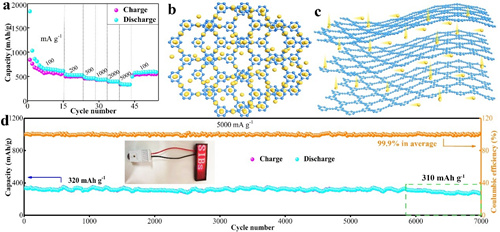[ Instrument Network Instrument Development ] The Carbon-based Materials and Energy Application Research Group of the Qingdao Institute of Bioenergy and Process Research, Chinese Academy of Sciences found that by controlling the number of acetylenic bonds in the molecular design of graphene carbon materials, more sodium storage sites are added. The transport channel, in order to prepare a sodium storage material with better electrochemical performance, its excellent specific capacity and long cycle stability indicate that the graphite alkyne carbon material has great application potential in energy storage.

Since sodium is abundant and cheap in the world, the cost of sodium ion batteries and capacitors is significantly lower than that of lithium ion batteries. Especially for large energy storage devices, sodium ion batteries and capacitors have more sustainable advantages. Therefore, the research of sodium ion batteries has quickly attracted the attention of researchers all over the world. However, the specific capacity of commercial graphite as a negative electrode material for sodium ion batteries and capacitors is too low, which seriously restricts the further development of sodium ion batteries and capacitors. For this reason, the worldwide research group has carried out exploration of new negative electrode materials. Research work, including the development and exploration of new carbon-based materials.
In recent years, carbonized graphite, hard carbon, graphene, etc., which are developed as negative electrode materials for sodium ion batteries and capacitors, have advantages such as low cost, low potential, and large capacity, and are considered to be promising candidate materials. However, the low capacity and cycle stability prevalent in these carbon negative electrodes is a problem that has been to be improved. The carbon-based materials and energy application research group has long been committed to the research of sodium ion battery and capacitor electrode materials, and developed a graphite ion-based sodium ion battery and capacitor anode material. Because of its rich acetylene bond, the graphite alkyne anode Sodium storage shows superior electrochemical performance, including porous graphite alkyne directly applied to sodium ion battery anodes (J. Mater. Chem. A 2017, 5, 2045-2051), nitrogen-doped graphite alkyne for high power Density and energy density of sodium ion capacitors (ChemElectroChem 2018, 5, 1435-1443), graphene alkyne nanowalls to obtain high performance sodium ion capacitors (ACS Appl. Mater. Interface, 2017, 9, 40604-40613). On this basis, through the molecular design of the graphite alkyne, the introduction of hydrogen and the preparation of a hydrogen-substituted graphite acetylene-based carbon material with uniform defects, and the introduction of hydrogen instead of the graphite alkyne, showed higher in the storage of sodium. Theoretical specific capacity (>1200 mAh g-1) and experimental specific capacity (>600 mAh g-1), and cycle stability performance with excellent rate performance (Nat. Commun., 2017, 8, 1172).
Especially recently, the research team designed and prepared hydrogen-substituted graphene acetylene (HsGY), in which a large number of acetylene bond macropores and mesoporous structures facilitate the rapid penetration of electrolytes, shorten the path of diffusion and transport, and improve the rate performance of the electrodes. And cycle stability (as shown). At a current density of 100 mAh g-1, the HsGY electrode is capable of achieving a high reversible specific capacity of up to 680 mAh g-1. Even at current densities up to 5000 mA g-1, the specific capacity of the HsGY electrode can be stabilized at 330 mAh g-1. Thanks to the characteristics of HsGY electrode materials and two-dimensional and three-dimensional layered porous materials, sodium ions can be stored in a large amount in the in-plane and out-of-plane of HsGY, while sodium ions can easily diffuse or migrate in the HsGY layer. . The stability test showed that the cycle was 5900 cycles at a high current density of 5000 mAh g-1, and the reversible capacity was also stabilized at 320 mAh g-1, resulting in an excellent capacity retention of 96%. Related results have been published in the international journal "Journal of Materials Chemistry A" (J. Mater. Chem. A (2019, 7, 11186-11194)).
The above research results have important guiding significance for the design, preparation, energy storage and catalysis of new carbon-based materials, and indicate that graphene-alky carbon materials have great potential in the development and application of energy equipment.
The research was supported by the National Natural Science Foundation of China, the key projects of the Chinese Academy of Sciences and the Natural Science Foundation of Shandong Province.
Wooden Color Coated Steel Coil
Wooden Color Coated Steel Coil,Wooden Color Coated Coil,Wooden Grain Steel Coil,Wooden Grain Aluminum Coil
WENZHOU ICL INDUSTRIAL CO., LTD. , https://www.cniclsteel.com